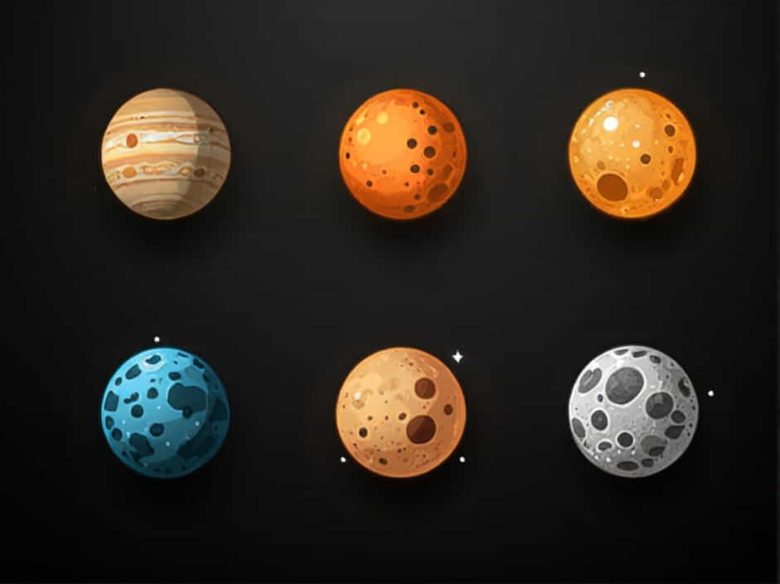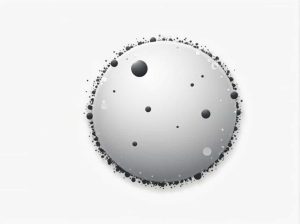Our solar system is home to many celestial bodies, including planets, moons, asteroids, and dwarf planets. These dwarf planets are fascinating worlds that do not fit the traditional definition of a planet, yet they share many similarities with them.
In this topic, we will explore what dwarf planets are, how they are classified, and take a closer look at the five officially recognized dwarf planets in our solar system.
1. What Is a Dwarf Planet?
A dwarf planet is a celestial body that shares some characteristics with regular planets but does not meet all the criteria set by the International Astronomical Union (IAU).
IAU Definition of a Dwarf Planet
According to the IAU, a dwarf planet must:
✔ Orbit the Sun.
✔ Have enough mass to be spherical or nearly round in shape.
✔ Not have cleared its orbit of other debris.
✔ Not be classified as a moon.
Because dwarf planets have not cleared their orbits, they are different from the eight major planets in our solar system.
2. How Many Dwarf Planets Are There?
Currently, five dwarf planets are officially recognized by the IAU:
- Pluto
- Eris
- Haumea
- Makemake
- Ceres
However, astronomers believe that there could be hundreds or even thousands of dwarf planets waiting to be discovered in the Kuiper Belt and beyond.
Now, let’s take a closer look at each of these five dwarf planets.
3. Pluto: The Most Famous Dwarf Planet
✔ Discovered: 1930
✔ Location: Kuiper Belt
✔ Diameter: 2,377 km
✔ Moons: 5 (including Charon)
Pluto was once considered the ninth planet in our solar system. However, in 2006, the IAU reclassified it as a dwarf planet due to its failure to clear its orbit of debris.
Interesting Facts About Pluto
- It has a thin atmosphere made of nitrogen, methane, and carbon monoxide.
- A day on Pluto lasts 153 hours (more than 6 Earth days).
- Pluto’s largest moon, Charon, is so big that the two bodies orbit a common center of gravity.
Despite being reclassified, Pluto remains one of the most beloved celestial objects in our solar system.
4. Eris: The Most Massive Dwarf Planet
✔ Discovered: 2005
✔ Location: Scattered Disk (beyond the Kuiper Belt)
✔ Diameter: 2,326 km
✔ Moons: 1 (Dysnomia)
Eris is the second-largest dwarf planet, but it is more massive than Pluto. Its discovery in 2005 sparked a debate that led to the reclassification of Pluto.
Interesting Facts About Eris
- It is one of the most distant known objects in the solar system.
- Its surface is extremely cold and icy, similar to Pluto.
- It takes 558 Earth years to complete one orbit around the Sun.
Eris helped change our understanding of planetary classification.
5. Haumea: The Fast-Spinning Dwarf Planet
✔ Discovered: 2004
✔ Location: Kuiper Belt
✔ Diameter: 1,632 km
✔ Moons: 2 (Hi’iaka and Namaka)
Haumea is unique because of its elongated, oval shape. This is due to its extremely fast rotation, completing a full spin in less than 4 hours.
Interesting Facts About Haumea
- It has a rocky core and a thin icy crust.
- Haumea is one of the fastest-spinning objects in the solar system.
- It has a ring, making it the only known dwarf planet with one.
Haumea’s unusual shape and rotation make it a fascinating object for astronomers.
6. Makemake: The Brightest Dwarf Planet in the Kuiper Belt
✔ Discovered: 2005
✔ Location: Kuiper Belt
✔ Diameter: 1,430 km
✔ Moons: None (until recently, a possible moon was detected)
Makemake is one of the largest dwarf planets and is known for its high reflectivity, meaning it reflects a lot of sunlight.
Interesting Facts About Makemake
- It is named after a Polynesian god of creation.
- Unlike Pluto, it has no significant atmosphere.
- It was one of the last major objects discovered in the Kuiper Belt.
Makemake’s brightness and icy surface make it stand out among other dwarf planets.
7. Ceres: The Only Dwarf Planet in the Asteroid Belt
✔ Discovered: 1801
✔ Location: Asteroid Belt (between Mars and Jupiter)
✔ Diameter: 946 km
✔ Moons: None
Ceres is the closest dwarf planet to Earth and the only one located in the asteroid belt. It is also the smallest of the five recognized dwarf planets.
Interesting Facts About Ceres
- It was the first dwarf planet discovered.
- Ceres has water ice beneath its surface, making it a candidate for potential microbial life.
- The NASA Dawn spacecraft explored Ceres, revealing mysterious bright spots on its surface.
Ceres is a fascinating world that provides insight into the early solar system.
8. Are There More Dwarf Planets?
Astronomers believe that many other dwarf planets exist in the Kuiper Belt and beyond. Some possible candidates include:
✔ Orcus
✔ Quaoar
✔ Sedna
✔ Gonggong
Future space missions may discover more dwarf planets and help us understand these mysterious worlds.
9. Why Are Dwarf Planets Important?
Dwarf planets provide valuable insights into the formation of the solar system. Studying them helps scientists understand:
✔ The history of planetary formation.
✔ The composition of icy bodies in the outer solar system.
✔ The potential for life on other celestial objects.
Even though they are not classified as full planets, they are still important members of our solar system.
Dwarf planets are unique and fascinating worlds that offer a glimpse into the mysteries of space. The five officially recognized dwarf planets—Pluto, Eris, Haumea, Makemake, and Ceres—each have their own special characteristics and contribute to our understanding of the solar system.
As technology advances, astronomers will continue to explore and discover more dwarf planets, expanding our knowledge of the universe.



